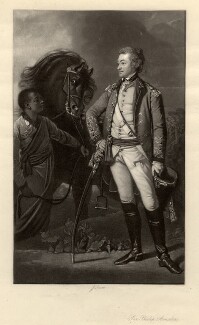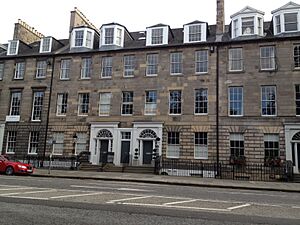Philip Ainslie facts for kids
Sir Philip Ainslie of Pilton (born 1728, died 1802) was an important Scottish landowner. He was also a high-ranking officer, a Colonel, in a famous army group called the 7th Dragoons.
Contents
A Look at Philip Ainslie's Life
Philip Ainslie was born in 1728 in Pilton, Edinburgh, Scotland. He was the second son of George Ainslie, who was a successful merchant. A merchant is someone who buys and sells goods to make money. His father made a lot of money in Bordeaux, France.
Philip had two brothers who also became well-known. His older brother was General George Ainslie, a high-ranking army officer. His younger brother was Sir Robert Ainslie, 1st Baronet.
Joining the Army and Becoming a Knight
Philip went to school at Westminster School, a famous school in London. In 1754, he joined the British Army. He served as a Lieutenant Colonel in Portugal, which means he was a senior officer.
He also worked as an aide-de-camp for Prince Charles of Mecklenburg. An aide-de-camp is like a personal assistant to a high-ranking military officer or royal. In 1778, King George III made him a knight. This was a special honor given for his service.
Later Years in Edinburgh
In 1784, Sir Philip lived in a new house at 38 St Andrews Square in Edinburgh's New Town. This area was just being built at the time.
He retired from the army in 1786. Sir Philip Ainslie passed away on May 19, 1802, when he was 74 years old. He spent his last years living at 57 Queen Street in Edinburgh.
Sir Philip's Family
In March 1772, Sir Philip Ainslie married Elizabeth Gray in Edinburgh. She was the daughter of John Gray, 11th Lord Gray.
They had a son named George Robert Ainslie, who also became a General. Their son later divided the family's Pilton estate into two parts: East Pilton and West Pilton farms.
Sir Philip's daughter, Margaret Jane Ainslie, married Francis Stuart, 10th Earl of Moray.
Artistic Recognition
A famous artist named Sir Joshua Reynolds painted a portrait of Sir Philip Ainslie. A portrait is a painting of a person. This painting was later made into a mezzotint by James Scott. A mezzotint is a type of print that looks like a painting.



